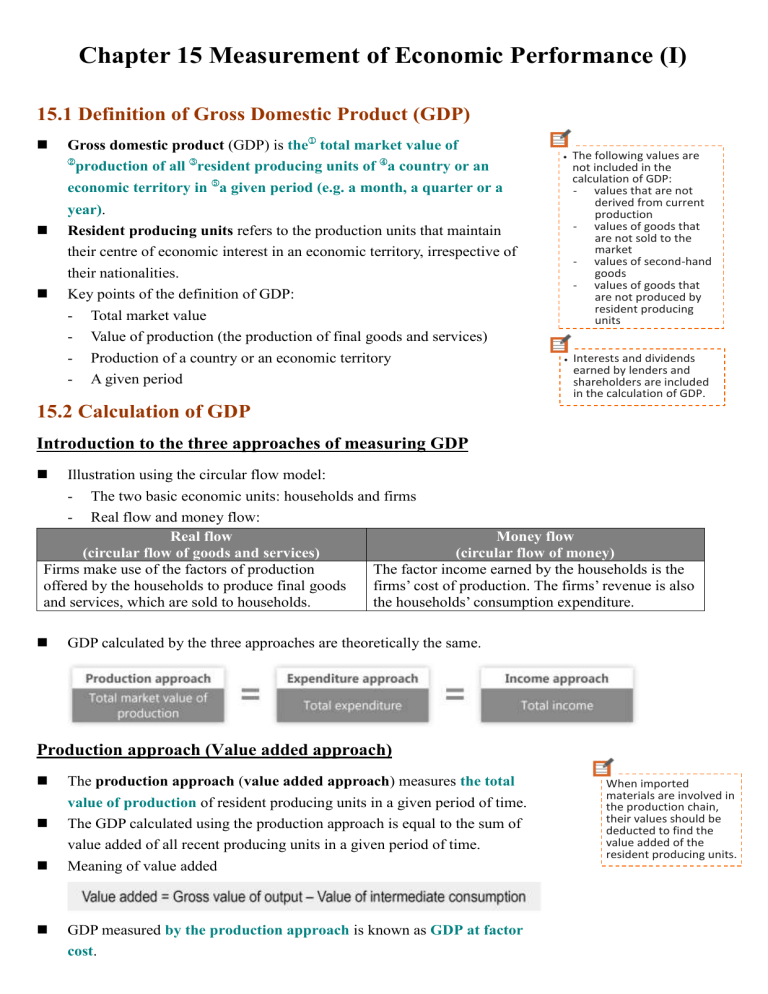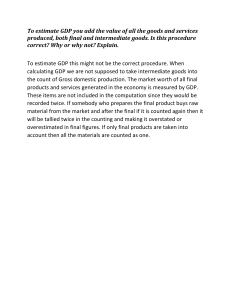
Chapter 15 Measurement of Economic Performance (I) 15.1 Definition of Gross Domestic Product (GDP) Gross domestic product (GDP) is the① total market value of ② production of all ③resident producing units of ④a country or an economic territory in ⑤a given period (e.g. a month, a quarter or a The following values are not included in the calculation of GDP: - values that are not derived from current production - values of goods that are not sold to the market - values of second-hand goods - values of goods that are not produced by resident producing units Interests and dividends earned by lenders and shareholders are included in the calculation of GDP. year). Resident producing units refers to the production units that maintain their centre of economic interest in an economic territory, irrespective of their nationalities. Key points of the definition of GDP: - Total market value - Value of production (the production of final goods and services) - Production of a country or an economic territory - A given period 15.2 Calculation of GDP Introduction to the three approaches of measuring GDP Illustration using the circular flow model: - The two basic economic units: households and firms Real flow and money flow: Real flow Money flow (circular flow of goods and services) (circular flow of money) Firms make use of the factors of production The factor income earned by the households is the offered by the households to produce final goods firms’ cost of production. The firms’ revenue is also and services, which are sold to households. the households’ consumption expenditure. GDP calculated by the three approaches are theoretically the same. Production approach (Value added approach) The production approach (value added approach) measures the total value of production of resident producing units in a given period of time. The GDP calculated using the production approach is equal to the sum of value added of all recent producing units in a given period of time. Meaning of value added GDP measured by the production approach is known as GDP at factor cost. When imported materials are involved in the production chain, their values should be deducted to find the value added of the resident producing units. Expenditure approach The expenditure approach measures the total expenditure on final goods and services produced by resident producing units in a given period of time. GDP measured by the expenditure approach is known as GDP at market prices. The GDP calculated using the expenditure approach can be calculated using the following formula: Private consumption expenditure (C) refers to consumption expenditures by households and private non-profit institutions on currently produced final goods and services. Gross investment (I) refers to the expenditure made mainly by firms on final goods and services, especially on capital goods. Government consumption expenditure (G) includes government purchases of goods and services and payments made to government employees. Net exports (NX) refers to the difference between the value of total exports (X) and the value of total imports (M) of goods and services. The value of unsold final goods produced in the current year is included in GDP as changes in inventories. Transfer payments provided by the government are not included in government consumption expenditure. Income approach The income approach measures GDP by summing the income received by factors of production from providing factor service. It is equal to the sum of compensation of employees and gross operating surplus of firms. Components of the GDP compiled under the income approach are not required in the curriculum. 15.3 GDP at Market Prices and GDP at Factor Cost GDP at market prices may be different from GDP at factor cost. The difference can be due to indirect taxes and subsidies. The difference can be expressed using the following formula: Indirect taxes With indirect taxes, the amount paid by consumers (i.e. GDP at market prices) is higher than the amount received by factor owners (i.e. GDP at factor cost) Subsidies With subsidies, the amount paid by consumers (i.e. GDP at market prices) is lower than the amount received by factor owners (i.e. GDP at factor cost) ⚠️ Examples to determine whether certain items should be included in calculation of GDP Item(s) Incl. Reason / Excl. Production by households for their own ✘ The production does not have a market value as it has not gone through the market. consumption Non-market activities / illegal ✓/✘ The data from such activities is difficult to collect so their value is often not included in GDP calculations of many economies. transactions Value of second-hand These goods are not involved in the production of the current period. Their value ✘ goods was included in the GDP of the period in which they were produced or sold for the first time. Middleman charges paid for ✓ They reflect the value of services provided by the middleman in the current period. Dividends ✓ It represents the return to shareholders on production activities. Capital gain ✘ It’s not a result of production. ✘ The transaction only represents a transfer of wealth. No production is involved. ✓ They reflect the value of services provided in the current period. the transactions of second-hand goods Value of financial assets (e.g. shares and bonds) Commissions and charges paid for the transactions of financial assets Transfer payment (e.g. unemployment ✘ They are merely a transfer of wealth. Since no goods and services are produced in exchange for the benefit, no production is involved. benefits) Transaction of imported goods Inventories (unsold good) ✘ Not produce by Hong Kong RPU. ✘ Not produced in the current period.






